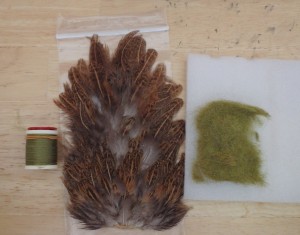Bird of prey caddis
This is a pattern that I’ve grown to love. It was developed by John Anderson (no relation to Bill-as far as I know). It fishes very well in the area, including the J. The video is produced by Tim Cammisa. He produces excellent tying videos. I enjoy watching and he produces some professional looking videos. His library can be found on youtube by clicking his name above.
Like most fly tyers, I (jcr) have my own style and variations on this pattern that is described below. This is not a critique of Tim’s fly or methods. My method of tying is very similar and I could never produce videos of equal quality. I prefer the following modifications, however.
- I use gold (or green in some cases) ultra wire instead of the flash for ribbing, especially for the olive pattern. I have found that the flash is easily broken by the hard takes of aggressive trout.
- I extend the partridge tail down the hook bend a little more.
- As Tim mentions, he prefers a sparser hackle, I a heavier hackle. These are meant to be fished in fast, deep runs and the soft hackle fibers are lost. Furthermore, I tend to tie my hackles heavier and trim them appropriately on the stream based on water conditions. Deeper, colored water or fished at dusk=more; skinny, clear water=less.
- I would use three peacock fibers on the size of fly shown in the video to produce a larger head that is a bit larger than the bead. I add a drop of cement after tying in the hackle, but before wrapping the peacock to add durability to the hackle and head.
My materials:
Hook: TMC2487 sz14-18
Thread: UTC 70 olive
Bead: Tungsten gold 2.0 mm , 1.5mm sz18
Rib: gold ultra wire. BR (sz14); SM (sz16 and 18)
Dubbing: Haretron rabbit HT6
Underwing (Optional): 6-8 strands of olive antron (sz14 and 16), body length
Hackle: dark partridge or brown hen back (speckled, light shade)
Head: three strands of peacock. Match thickness/density to the size of fly.




